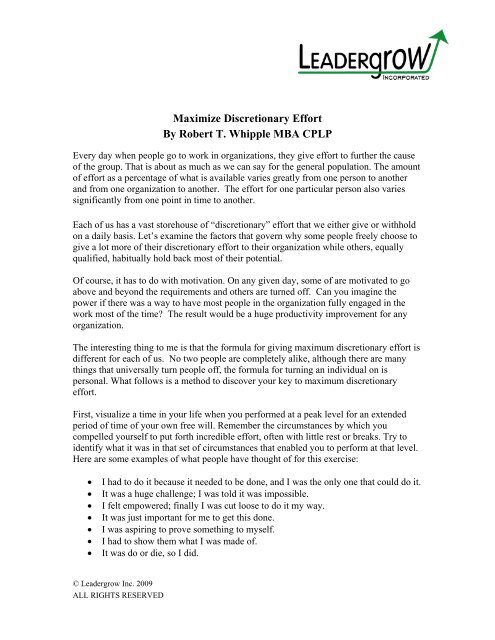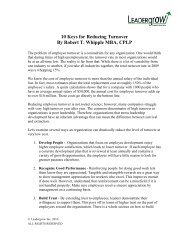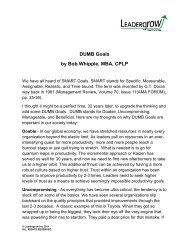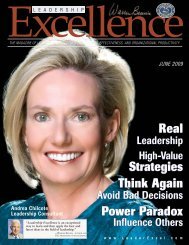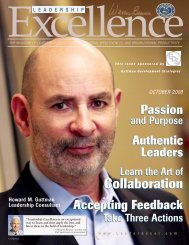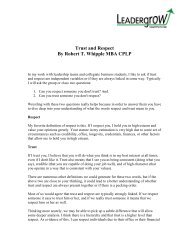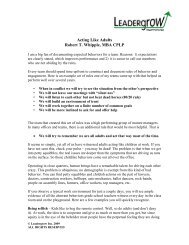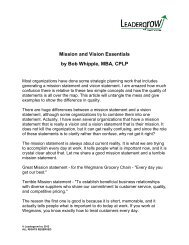Maximize Discretionary Effort - Powered by ZD-CMS
Maximize Discretionary Effort - Powered by ZD-CMS
Maximize Discretionary Effort - Powered by ZD-CMS
You also want an ePaper? Increase the reach of your titles
YUMPU automatically turns print PDFs into web optimized ePapers that Google loves.
<strong>Maximize</strong> <strong>Discretionary</strong> <strong>Effort</strong><br />
By Robert T. Whipple MBA CPLP<br />
Every day when people go to work in organizations, they give effort to further the cause<br />
of the group. That is about as much as we can say for the general population. The amount<br />
of effort as a percentage of what is available varies greatly from one person to another<br />
and from one organization to another. The effort for one particular person also varies<br />
significantly from one point in time to another.<br />
Each of us has a vast storehouse of “discretionary” effort that we either give or withhold<br />
on a daily basis. Let’s examine the factors that govern why some people freely choose to<br />
give a lot more of their discretionary effort to their organization while others, equally<br />
qualified, habitually hold back most of their potential.<br />
Of course, it has to do with motivation. On any given day, some of are motivated to go<br />
above and beyond the requirements and others are turned off. Can you imagine the<br />
power if there was a way to have most people in the organization fully engaged in the<br />
work most of the time? The result would be a huge productivity improvement for any<br />
organization.<br />
The interesting thing to me is that the formula for giving maximum discretionary effort is<br />
different for each of us. No two people are completely alike, although there are many<br />
things that universally turn people off, the formula for turning an individual on is<br />
personal. What follows is a method to discover your key to maximum discretionary<br />
effort.<br />
First, visualize a time in your life when you performed at a peak level for an extended<br />
period of time of your own free will. Remember the circumstances <strong>by</strong> which you<br />
compelled yourself to put forth incredible effort, often with little rest or breaks. Try to<br />
identify what it was in that set of circumstances that enabled you to perform at that level.<br />
Here are some examples of what people have thought of for this exercise:<br />
• I had to do it because it needed to be done, and I was the only one that could do it.<br />
• It was a huge challenge; I was told it was impossible.<br />
• I felt empowered; finally I was cut loose to do it my way.<br />
• It was just important for me to get this done.<br />
• I was aspiring to prove something to myself.<br />
• I had to show them what I was made of.<br />
• It was do or die, so I did.<br />
© Leadergrow Inc. 2009<br />
ALL RIGHTS RESERVED
• My team believed in my, so I had to do it.<br />
• I understood the goal and it was important to me.<br />
Keep working at it until you have identified the true essence of what enabled you to<br />
perform at that level. Write it down in one single sentence.<br />
The sentence you wrote will be your personal specification for giving your maximum<br />
discretionary effort. Many times in life you can configure work to align with this kind of<br />
statement. When you do, you will instinctively be performing with at least twice the<br />
productivity of your usual pace.<br />
The beauty of this simple exercise comes when you do it as a group activity. I recall one<br />
meeting where I had a corporate Vice President with his whole team, and we did this<br />
exercise. It turns out the VP was most energized when he had to parachute into the<br />
jungle with a knife between his teeth. His subordinates were turned on when they were<br />
trusted and empowered to get things done in their own way. The ensuing discussion<br />
revealed why there had been so much tension in the organization. Subsequent retraining<br />
of the VP led to much higher performance among his direct reports.<br />
You can do this experiment at any level in the organization. Not only will it help you<br />
understand yourself better, it will also give you new insight into how to lead your<br />
employees.<br />
The preceding information was adapted from the book, The TRUST Factor: Advanced<br />
Leadership for Professionals, <strong>by</strong> Robert Whipple. It is available on<br />
www.leadergrow.com.<br />
Robert Whipple is also the author of Understanding E-Body Language: Building Trust<br />
Online, and Leading with Trust is like Sailing Downwind. Bob consults and speaks on<br />
these and other leadership topics. He is CEO of Leadergrow Inc. a company dedicated to<br />
growing leaders. Contact Bob at bwhipple@leadergrow.com or<br />
585-392-7763.<br />
© Leadergrow Inc. 2009<br />
ALL RIGHTS RESERVED


